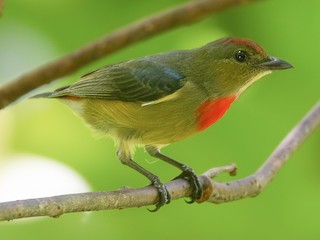Louisiade Flowerpecker Dicaeum nitidum Scientific name definitions
Text last updated October 21, 2013
Sign in to see your badges
Species names in all available languages
| Language | Common name |
|---|---|
| Bulgarian | Луизиадски цветояд |
| Catalan | picaflors de les Louisiade |
| Croatian | žućkastotrba imelašica |
| Dutch | Louisiadenhoningvogel |
| English | Louisiade Flowerpecker |
| English (United States) | Louisiade Flowerpecker |
| French | Dicée de Louisiade |
| French (Canada) | Dicée de Louisiade |
| German | Louisiadenmistelfresser |
| Japanese | ルイジアードハナドリ |
| Norwegian | louisiadeblomsterfugl |
| Polish | kwiatówka wyspowa |
| Russian | Луизиадский цветоед |
| Serbian | Cvetarka sa arhipelaga Luizijada |
| Slovak | bobuliar lesklý |
| Spanish | Picaflores de las Luisiadas |
| Spanish (Spain) | Picaflores de las Luisiadas |
| Swedish | louisiadblomsterpickare |
| Turkish | Luisiad Adaları Öksekuşu |
| Ukrainian | Квіткоїд острівний |
Dicaeum nitidum Tristram, 1889
Definitions
- DICAEUM
- nitidum / nitidus
The Key to Scientific Names
Legend Overview
Field Identification
9 cm. Male nominate race has dull red cap, brighter red rump, rest of upperparts dark brownish-grey, glossed blue and green (particularly on mantle and upperwing-coverts); remiges blackish-brown, edged greenish, tail glossy blackish; side of head greyish; chin and throat whitish, bright red patch on breast, rest of underparts yellowish-olive, paler on central belly and undertail-coverts, pectoral tufts white; iris brown; bill black, base of lower mandible whitish; legs black. Female differs from male in lacking red breast patch. Juvenile differs from adult female in lacking red on upperparts. Race rosseli male has shoulders glossed blue-green, and is more dark olive-green, less blackish-looking, above than nominate.
Systematics History
Editor's Note: This article requires further editing work to merge existing content into the appropriate Subspecies sections. Please bear with us while this update takes place.
Considered conspecific with D. pectorale and/or D. geelvinkianum by some authors (1, 2). Two subspecies recognized.Subspecies
Dicaeum nitidum nitidum Scientific name definitions
Distribution
Dicaeum nitidum nitidum Tristram, 1889
Definitions
- DICAEUM
- nitidum / nitidus
The Key to Scientific Names
Legend Overview
Dicaeum nitidum rosseli Scientific name definitions
Distribution
Dicaeum nitidum rosseli Rothschild & Hartert, 1914
Definitions
- DICAEUM
- nitidum / nitidus
- rosseli / rosseliana / rosselianus
The Key to Scientific Names
Legend Overview
Distribution
Editor's Note: Additional distribution information for this taxon can be found in the 'Subspecies' article above. In the future we will develop a range-wide distribution article.
Habitat
Forest and secondary growth.
Movement
No information.
Diet and Foraging
Fruits, presumably including those of mistletoes (Loranthaceae), and spiders (Araneae). Forages in canopy, singly or in pairs.
Sounds and Vocal Behavior
Short, dry, buzzing insect-like note; single high-pitched upslurred note.
Breeding
No information.
Conservation Status
Not globally threatened. Restricted-range species: present in Louisiade Archipelago EBA. Very poorly known species. Appears not to be at any risk.

- Year-round
- Migration
- Breeding
- Non-Breeding













































